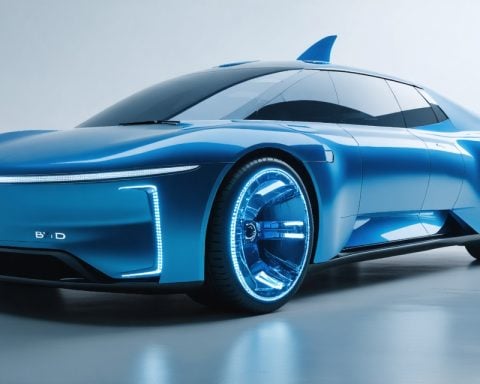- Nvidia is spearheading a transformation in personal computing with its new SOCAMM memory module, in collaboration with Samsung Electronics and SK Hynix.
- SOCAMM, featuring advanced LPDDR5X DRAM, offers enhanced efficiency and an impressive 694 I/O ports for superior performance over older technologies.
- Jensen Huang, Nvidia’s CEO, envisions SOCAMM as a democratizing force for AI, potentially turning regular PCs into powerful AI-driven machines.
- Mass production of SOCAMM is expected by the end of the year, challenging existing standards set by JEDEC.
- Nvidia’s venture could significantly impact memory technology and personal computing, heralding a new era of AI-powered solutions.
- Companies like Simmtech and TLB are part of Nvidia’s strategic play, which aims to integrate AI into everyday computing experiences.
A groundbreaking transformation is quietly vibrating through the corridors of tech giants. Nvidia propels itself into the arena with a daring strategy to reshape personal computing. Emerging from whispered exchanges between Nvidia and industry behemoths Samsung Electronics and SK Hynix, SOCAMM—a next-generation memory module—promises to catapult AI-driven personal supercomputers into a new epoch.
SOCAMM, a marvel conceived by Nvidia CEO Jensen Huang, symbolizes a leap in memory technology. It elegantly integrates LPDDR5X DRAM, a step ahead with its superior efficiency and neat, upgradeable architecture. Imagine a cityscape where speedways replace bottlenecks, much like SOCAMM achieves with its remarkable 694 I/O ports, leaving older LPCAMM’s 644 ports in the dust.
This is more than technological advancement; it is Huang’s bold vision to democratize AI. Such democratization envisions empowered AI PCs, each embedded with Nvidia’s cutting-edge Digits model, transforming mundane desktops into powerhouse performers.
With mass production anticipated by the year’s end, Nvidia is not just tossing a stone into the pond—it seeks to create ripples, challenging JEDEC’s longstanding industry standards. As the corporate drama unfolds, ancillary players like Simmtech and TLB find themselves swept into Nvidia’s audacious maneuvers.
Ultimately, Nvidia’s stride into AI with SOCAMM might not just influence memory technology. It could redefine personal computing, heralding an era where AI-driven hardware became as ubiquitous and essential as the very air we breathe, normalizing a future where AI is integral to every home and office. This innovative blueprint hints at a thrilling prospect: the future of personal computing may belong to targeted, AI-powered solutions—a possible paradigm shift we can only begin to imagine.
Nvidia’s Revolutionary SOCAMM: Is This the Future of AI-Driven PCs?
How SOCAMM is Disrupting the Memory Module Landscape
Nvidia’s pioneering strategy with SOCAMM, which stands for System-On-Chip Advanced Memory Module, is reshaping the realm of personal computing. By integrating LPDDR5X DRAM, SOCAMM offers superior efficiency and sleek upgradeability compared to previous technologies like LPCAMM. As the tech community anticipates its mass production, here’s what you need to know about SOCAMM’s potential impact and how this innovation is steering the future trajectory of AI-driven personal supercomputers.
Real-World Use Cases
SOCAMM promises to enhance AI capabilities in personal computers, enabling them to handle more complex tasks with ease. This would be beneficial in various domains, such as:
– AI-Powered Personal Assistants: Supercharging digital assistants to process and respond to queries more dynamically.
– Content Creation: Offering creatives tools to instantly render graphics or edit videos with AI enhancements.
– Data Analysis: Allowing researchers to process large datasets more efficiently without needing a high-end server setup.
Market Forecasts & Industry Trends
The global memory module market is poised to expand rapidly with the advent of technologies like SOCAMM. According to data forecasts:
– Increased Adoption of AI Hardware: The AI hardware market is expected to grow at a CAGR of 20.1% from 2023 to 2030 (Grand View Research).
– Memory Modules Demand: The need for faster and more efficient memory modules is increasing as AI penetrates deeper into consumer technology.
Reviews & Comparisons
Compared to previous iterations such as LPCAMM, SOCAMM not only offers increased I/O ports (694 versus 644) but also exhibits improved power efficiency, which is crucial for sustained AI operations. Tech reviewers anticipate a positive reception due to its superior architecture, although they point out the need for benchmarks in real-world scenarios for comprehensive assessments.
Controversies & Limitations
While SOCAMM is groundbreaking, it challenges JEDEC’s established industry standards, potentially creating friction with existing manufacturers. Additionally, its success hinges on widespread adoption, which may take time due to the required updates in infrastructure and technology alignment within the industry.
Features, Specs & Pricing
– Features: SOCAMM integrates Nvidia’s advanced Digits model, offering significant AI processing power.
– Specs: Utilizing LPDDR5X, SOCAMM boasts 694 I/O ports.
– Pricing: Though not officially disclosed, expectations are set high due to its advanced technology and capability spectrum.
Security & Sustainability
SOCAMM’s design prioritizes energy efficiency, enabling lower power consumption—a sustainable choice for both manufacturers and consumers. However, as with any new tech, security protocols will need rigorous vetting to ensure data protection in AI applications.
Insights & Predictions
With Nvidia’s strategic movements, the dynamic of personal computing is poised for significant transformation. Key insights include:
– AI Prevalence: AI is set to become integral to everyday computing.
– Competitive Landscape: Nvidia’s advancements could push rivals to innovate rapidly, accelerating industry growth.
Pros & Cons Overview
– Pros: Enhanced AI capabilities, increased efficiency, potential for widespread AI democratization.
– Cons: High initial costs, possible compatibility issues, regulatory challenges.
Actionable Recommendations
1. Stay Informed: Follow updates from Nvidia and industry news to keep abreast of developments.
2. Evaluate Infrastructure: Businesses and tech enthusiasts should assess their current systems’ compatibility with SOCAMM.
3. Invest in Future: Consider allocations towards advanced AI technologies for long-term benefits.
For more information on Nvidia’s latest innovations, visit link name.
In conclusion, Nvidia’s SOCAMM is not just a technological marvel—it’s a potential herald of a new era in personal computing where AI-powered solutions become commonplace. Keep an eye on this space for an exciting evolution in how we interact with technology.















